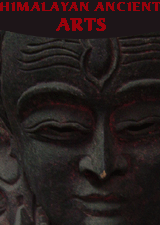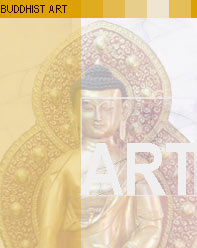Shop
By Type |
 |
|
|
|
|
|
|
|
|
|
|
|
|
|
|
|
|
|
|
|
|
|
|
|
|
|
|
|
|
|
|
|
|
|
|
|
|
|
|
|
|
|
|
|
|
|
|
|
|
|
|
|
|
|
|
|
|
|
|
|
|
 |
 |
Travel Packages  |
 |
 |
Newsletter |
 |
|
|
 |
|
 |
|
 |
|
 |
|
 |
|
 |
|
 |
|
 |
|
|
|
|
Buddhist arts are as old as Buddhism itself. Buddhist arts means art which relates to Buddhism and on the other arts which is produced by Buddhist. Both of these could be described as Buddhist art. Buddhist arts reflects very faithfully all the important aspects of Buddhism. Buddhist throughout the centuries have created images and symbols for one or more of three basic reasons.
|
| ............................................................................................................................................................................................................................ |
 |
Buddhist Arts as focus for devotion |
| Most Buddhist will have some kind of shrine in their home. This will perhaps have an image of the Buddha, a candle or two, and maybe also a place to burn incense. Buddhist temples around the world are famous for their awe-inspiring beauty. Both the temple and the shrine are symbolic representations of what Buddhist regard as most important in life. They encourage us to devote ourselves to that which we regard as most important. |
| |
| Buddhist Arts as aid to meditation |
|
The 'Buddha figure' or rupa is one of the most widely recognised symbols. in the world. But it did not emerge until at least two hundred years after the Buddha's death.
The Buddha image was probably developed as an aid to the 'recollection of the qualities of a Buddha' meditation practice. The figure represents balance, harmony, wisdom and compassion. It is the personification of an ideal.
During the emergence of Mahayana ('Greater Vehicle') Buddhism, this practice evolved and new Buddha forms emerged, emphasising particular qualities of enlightenment. These figures
|
| can be seen as different 'doorways' leading to the same, all encompassing enlightenment experience.
There is now a whole pantheon of Buddha and Bodhissatva figures. They are male, female or in union, and may be depicted in peaceful or wrathful form. There can be as many as 108 forms of any given figure. |
| Buddhist Arts means of self-expression |
Buddhist practice is an enriching and often challenging undertaking. It is a path of profound personal change. It changes the way the practitioner sees themselves, the universe and the way self and universe are related. It is not surprising then, that many should feel a desire, and even a need, to express these new perspectives artistically. Indeed for some, the artistic process itself is a significant part of their practice as Buddhist. |
| |
There are also references in texts to vanished visual art forms. Art in less permanent media must also have been produced at the same time as the art in stone, and indeed probably before monumental art in stone. However, paintings, drawings and statues in perishable materials, such as wood and fabric have not survived the ravages of time. The Pali canon contains a number of references to the lost visual art forms of the Buddha's period. Two references are very interesting. First, in the Vinaya pi§aka there is a reference to a picture gallery erected by king Bimbas¹ra which is apparently a place of public amusement, a kind of art gallery. Unfortunately it becomes the origin of a rule that nuns should not go to art galleries. There is also a reference by the Buddha to paintings displayed by wandering story tellers.
From the third century BCE onwards sculptural art in stone was being produced at Buddhist sacred sites. Particularly of note are the railings from Barhut and Sanchi stØpa s in Madhya Pradesh and the Bodh Gaya temple in Bihar . These are all representative of some of the earliest Buddhist art forms. There are also important early remains from the stØpa at Amravati in Andhra Pradesh and the cave temples of Maharashtra .
It is particularly striking that there is a profusion of three major types of imagery on these monuments. First there are depictions of stories from the previous lives of the Buddha, the j¹taka tales; second there are depictions of the lives of the previous Buddhas and third, there are depictions of key events in the life of sakyamuni Buddha.
It was it appears conventional to represent the life of sakyamuni Buddha, and previous Buddhas in terms of certain symbolic key events. A standing woman holding on to a tree giving birth represents the Buddha's birth. A platform under a tree being worshipped represent the enlightenment. A wheel on a pillar represents the first teaching and a stØpa represents sakyamuni Buddha's parinirv¹ªa . However, these symbolic scenes often also represent earlier Buddha's lives. For instance there is an enlightenment scene from the Bodh Gaya railings in which it can be seen that the leaves are the wrong shape for a Bodhi tree of ˜akyamuni Buddha, the Peepal tree, but the right shape for the leaves of the Bodhi tree of Ka¶ yapa Buddha, the [Asvatha?] tree. |
| |
| Non-Buddhist elements in Buddhist arts |
One issue that comes up when looking at the early Buddhist art is does it fit the definition of being concerned with Buddhist themes. It includes depictions of the sun god SØrya, serpent deities of N¹ga s and tree goddesses and gods or Yak¬» s and Yak¬as . In what sense are these Buddhist. The answer seems to be yes as all of these figures have been incorporated into the Buddhist tradition. There are description of shrines, caitiya s, to N¹ga s, Yak¬» s and Yak¬as in the Pali canon which indicate that these were pre-existing traditions which were incorporated into Buddhism and which probably brought with them visual representations of these figures.
The Western Indian cave temple monuments are also very striking examples of early Buddhist art. They contain not only early sculptural art but the earliest Buddhist paintings at Ajanta preserved in the murals on the walls of the caves. These had been abandoned and were discovered by the British in the 19th century and attempts made to preserve their contents. There is also a relationship which is clear between the Ajanta murals and the earliest paintings preserved in manuscripts which date from the tenth century CE onwards. |
| |
|
 |
|
 |
| |
|
|
| |
| |
|
|
 My
Shopping Basket My
Shopping Basket |
 |
| |
 Best
Seller Best
Seller |
 |
 |
 |
|
Grape Pashmina Shawl |
| Price: US$
71.43 |
|
|
|
| |
 Start
with your budget Start
with your budget |
 |
|
|
| |
 Tell
a friend Tell
a friend |
 |
Tell a friend and win exciting gifts...
Click here
to learn more. |
 |
 |
 |
 |
 |
 |
 |
| |
 |
|